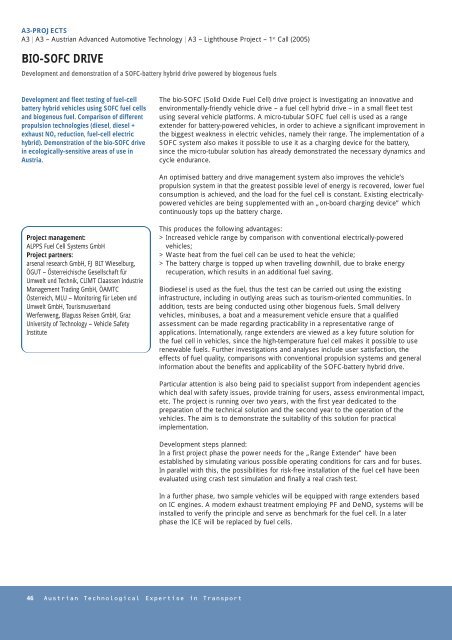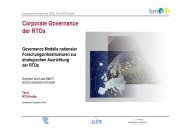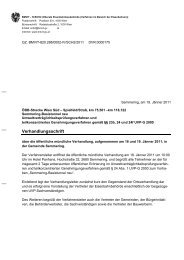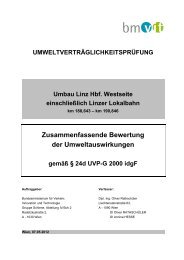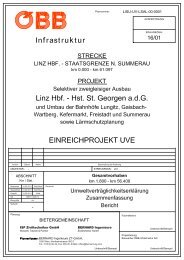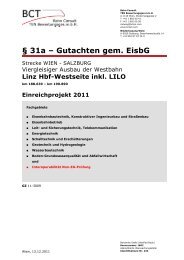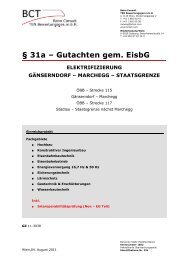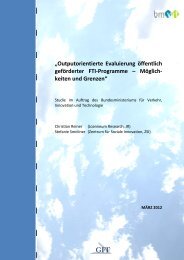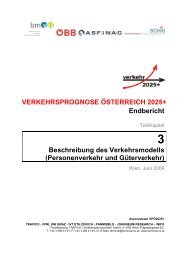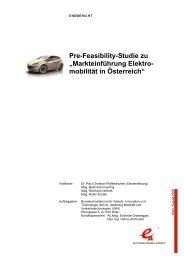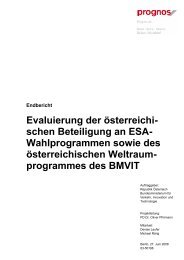Schriftenreihe .;technologiekompetenz Verkehr in
Schriftenreihe .;technologiekompetenz Verkehr in
Schriftenreihe .;technologiekompetenz Verkehr in
Create successful ePaper yourself
Turn your PDF publications into a flip-book with our unique Google optimized e-Paper software.
A3-PROJECTS<br />
A3 | A3 – Austrian Advanced Automotive Technology | A3 – Lighthouse Project – 1 st Call (2005)<br />
BIO-SOFC DRIVE<br />
Development and demonstration of a SOFC-battery hybrid drive powered by biogenous fuels<br />
Development and fleet test<strong>in</strong>g of fuel-cell<br />
battery hybrid vehicles us<strong>in</strong>g SOFC fuel cells<br />
and biogenous fuel. Comparison of different<br />
propulsion technologies (diesel, diesel +<br />
exhaust NO X reduction, fuel-cell electric<br />
hybrid). Demonstration of the bio-SOFC drive<br />
<strong>in</strong> ecologically-sensitive areas of use <strong>in</strong><br />
Austria.<br />
Project management:<br />
ALPPS Fuel Cell Systems GmbH<br />
Project partners:<br />
arsenal research GmbH, FJ BLT Wieselburg,<br />
ÖGUT – Österreichische Gesellschaft für<br />
Umwelt und Technik, CLIMT Claassen Industrie<br />
Management Trad<strong>in</strong>g GmbH, ÖAMTC<br />
Österreich, MLU – Monitor<strong>in</strong>g für Leben und<br />
Umwelt GmbH, Tourismusverband<br />
Werfenweng, Blaguss Reisen GmbH, Graz<br />
University of Technology – Vehicle Safety<br />
Institute<br />
46 Austrian Technological Expertise <strong>in</strong> Transport<br />
The bio-SOFC (Solid Oxide Fuel Cell) drive project is <strong>in</strong>vestigat<strong>in</strong>g an <strong>in</strong>novative and<br />
environmentally-friendly vehicle drive – a fuel cell hybrid drive – <strong>in</strong> a small fleet test<br />
us<strong>in</strong>g several vehicle platforms. A micro-tubular SOFC fuel cell is used as a range<br />
extender for battery-powered vehicles, <strong>in</strong> order to achieve a significant improvement <strong>in</strong><br />
the biggest weakness <strong>in</strong> electric vehicles, namely their range. The implementation of a<br />
SOFC system also makes it possible to use it as a charg<strong>in</strong>g device for the battery,<br />
s<strong>in</strong>ce the micro-tubular solution has already demonstrated the necessary dynamics and<br />
cycle endurance.<br />
An optimised battery and drive management system also improves the vehicle’s<br />
propulsion system <strong>in</strong> that the greatest possible level of energy is recovered, lower fuel<br />
consumption is achieved, and the load for the fuel cell is constant. Exist<strong>in</strong>g electricallypowered<br />
vehicles are be<strong>in</strong>g supplemented with an „on-board charg<strong>in</strong>g device” which<br />
cont<strong>in</strong>uously tops up the battery charge.<br />
This produces the follow<strong>in</strong>g advantages:<br />
> Increased vehicle range by comparison with conventional electrically-powered<br />
vehicles;<br />
> Waste heat from the fuel cell can be used to heat the vehicle;<br />
> The battery charge is topped up when travell<strong>in</strong>g downhill, due to brake energy<br />
recuperation, which results <strong>in</strong> an additional fuel sav<strong>in</strong>g.<br />
Biodiesel is used as the fuel, thus the test can be carried out us<strong>in</strong>g the exist<strong>in</strong>g<br />
<strong>in</strong>frastructure, <strong>in</strong>clud<strong>in</strong>g <strong>in</strong> outly<strong>in</strong>g areas such as tourism-oriented communities. In<br />
addition, tests are be<strong>in</strong>g conducted us<strong>in</strong>g other biogenous fuels. Small delivery<br />
vehicles, m<strong>in</strong>ibuses, a boat and a measurement vehicle ensure that a qualified<br />
assessment can be made regard<strong>in</strong>g practicability <strong>in</strong> a representative range of<br />
applications. Internationally, range extenders are viewed as a key future solution for<br />
the fuel cell <strong>in</strong> vehicles, s<strong>in</strong>ce the high-temperature fuel cell makes it possible to use<br />
renewable fuels. Further <strong>in</strong>vestigations and analyses <strong>in</strong>clude user satisfaction, the<br />
effects of fuel quality, comparisons with conventional propulsion systems and general<br />
<strong>in</strong>formation about the benefits and applicability of the SOFC-battery hybrid drive.<br />
Particular attention is also be<strong>in</strong>g paid to specialist support from <strong>in</strong>dependent agencies<br />
which deal with safety issues, provide tra<strong>in</strong><strong>in</strong>g for users, assess environmental impact,<br />
etc. The project is runn<strong>in</strong>g over two years, with the first year dedicated to the<br />
preparation of the technical solution and the second year to the operation of the<br />
vehicles. The aim is to demonstrate the suitability of this solution for practical<br />
implementation.<br />
Development steps planned:<br />
In a first project phase the power needs for the „Range Extender” have been<br />
established by simulat<strong>in</strong>g various possible operat<strong>in</strong>g conditions for cars and for buses.<br />
In parallel with this, the possibilities for risk-free <strong>in</strong>stallation of the fuel cell have been<br />
evaluated us<strong>in</strong>g crash test simulation and f<strong>in</strong>ally a real crash test.<br />
In a further phase, two sample vehicles will be equipped with range extenders based<br />
on IC eng<strong>in</strong>es. A modern exhaust treatment employ<strong>in</strong>g PF and DeNO X systems will be<br />
<strong>in</strong>stalled to verify the pr<strong>in</strong>ciple and serve as benchmark for the fuel cell. In a later<br />
phase the ICE will be replaced by fuel cells.


